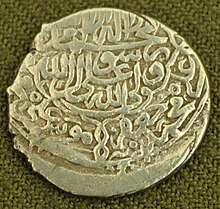Mohammed Khodabanda
| Sultan Mohammad Shah | |||||
|---|---|---|---|---|---|
| Shahanshah of Iran |
|||||

Coin minted during the reign of Mohammad Khodabandeh
|
|||||
| 4th Safavid Shah | |||||
| Reign | 11 February 1578 – October 1587 | ||||
| Predecessor | Ismail II | ||||
| Successor | Abbas I | ||||
| Born | 1532 | ||||
| Died | 1595 or 1596 (aged 63–64) | ||||
| Consort | Khayr al-Nisa Begum | ||||
| Issue |
|
||||
|
|||||
| Dynasty | Safavid | ||||
| Father | Tahmasp I | ||||
| Mother | Sultanum Begum Mawsillu | ||||
| Religion | Twelver Shi'a Islam | ||||
| Full name | |
|---|---|
| Mohammad Khodabandeh |
Mohammad Khodābandeh or Khudābanda, also known as Mohammad Shah or Sultan Mohammad (Persian: شاه محمد خدابنده, born 1532; died 1595 or 1596), was Shah of Persia from 1578 until his overthrow in 1587 by his son Abbas I. He was the fourth Safavid Shah of Iran and succeeded his brother, Ismail II. Khodabanda was the son of Shah Tahmasp I by a Turcoman mother, Sultanum Begum Mawsillu, and grandson of Ismail I, founder of the Safavid Dynasty.
After the death of his father in 1576 Mohammad was passed over in favour of his younger brother Ismail II. Mohammad suffered from an eye affliction that rendered him nearly blind, and so in accordance with Persian Royal culture could not contend for the throne. However, following Ismail II's short and bloody reign Mohammad emerged as the only heir, and so with the backing of the Qizilbash tribes became Shah in 1578.
Mohammad's reign was marked by a continued weakness of the crown and tribal infighting as part of the second civil war of the Safavid era. An important figure in the early years of Mohammad's reign was his wife Khayr Al-Nisa Begum, who helped secure her husband's reign. However her efforts to consolidate central power brought about opposition from the powerful Qizilbash tribes, who had her murdered in 1579. Mohammad has been described as "a man of refined tastes but weak character". As a result, Mohammad's reign was characterised by factionalism, with major tribes aligning themselves with Mohammad's sons and future heirs. This internal chaos allowed foreign powers, especially the rivalling and neighboring Ottoman Empire, to make territorial gains, including the conquest of the old capital of Tabriz in 1585. Mohammad was finally overthrown in a coup in favour of his son Shah Abbas I.
...
Wikipedia
